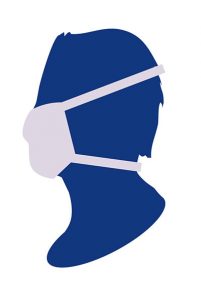
The UK Government is now recommending the use of face coverings in enclosed spaces where social distances might not be maintained.
If you can, wear a face covering in an enclosed space where social distancing isn’t possible and where you will come into contact with people you do not normally meet. This is most relevant for short periods indoors in crowded areas, for example, on public transport or in some shops.
Evidence suggests that wearing a face covering does not protect you.
However, if you are infected but have not yet developed symptoms, it may provide some protection for others you come into close contact with.
Face coverings do not replace social distancing.
If you have symptoms of COVID-19 (cough and/or high temperature), you and your household must isolate at home: wearing a face covering does not change this.
A face covering is not the same as the surgical masks or respirators used by healthcare and other workers as part of personal protective equipment. These should continue to be reserved for those who need them to protect against risks in their workplace, such as health and care workers, and those in industrial settings, like those exposed to dust hazards.
Face coverings should not be used by children under the age of 2 or those who may find it difficult to manage them correctly. For example, primary age children unassisted, or those with respiratory conditions.
Wearing a face covering
It is important to use face coverings properly and wash your hands before putting them on and taking them off.
A cloth face covering should cover your mouth and nose while allowing you to breathe comfortably. It can be as simple as a scarf or bandana that ties behind the head.
Wash your hands or use hand sanitiser before putting it on and after taking it off and after use. Avoid touching your eyes, nose, or mouth at all times and store used face coverings in a plastic bag until you have an opportunity to wash them.
Do not touch the front of the face covering, or the part of the face covering that has been in contact with your mouth and nose. Once removed, make sure you clean any surfaces the face covering has touched.
You should wash a face covering regularly. It can go in with other laundry, using your normal detergent.
When wearing a face covering, take care to tuck away any loose ends.
Home made face coverings
You can make face-coverings at home. The key thing is it should cover the mouth and nose.
Instructions for making face coverings:
- Public Health England:
www.gov.uk/government/publications/how-to-wear-and-make-a-cloth-face-covering/how-to-wear-and-make-a-cloth-face-covering - BBC
https://www.bbc.co.uk/news/uk-52609777 - Big Community Sew
https://www.bigcommunitysew.co.uk/
Cabinet Office, 11 May 2020
www.gov.uk/government/publications/staying-safe-outside-your-home/staying-safe-outside-your-home
Public Health England, 11 May 2020
www.gov.uk/government/publications/how-to-wear-and-make-a-cloth-face-covering/how-to-wear-and-make-a-cloth-face-covering

